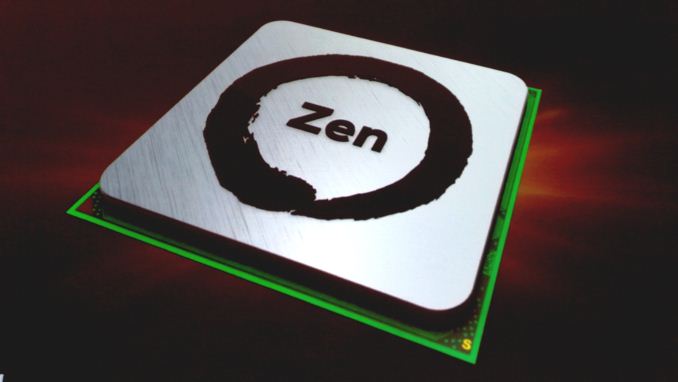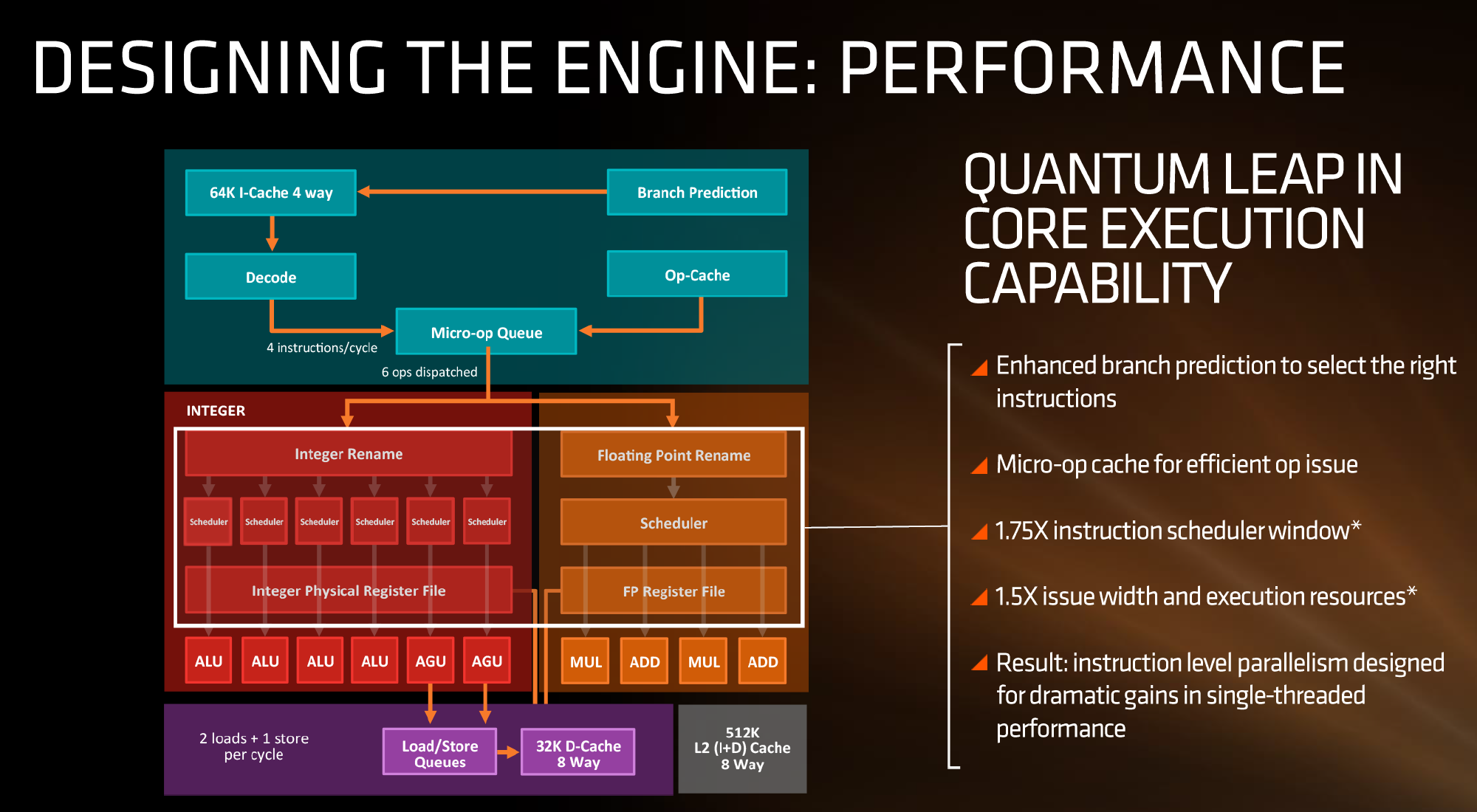AMD Zen Microarchitecture: Dual Schedulers, Micro-Op Cache and Memory Hierarchy Revealed
by Ian Cutress on August 18, 2016 9:00 AM EST
In their own side event this week, AMD invited select members of the press and analysts to come and discuss the next layer of Zen details. In this piece, we’re discussing the microarchitecture announcements that were made, as well as a look to see how this compares to previous generations of AMD core designs.
AMD Zen
Prediction, Decode, Queues and Execution
First up, let’s dive right into the block diagram as shown:
If we focus purely on the left to start, we can see most of the high-level microarchitecture details including basic caches, the new inclusion of an op-cache, some details about decoders and dispatch, scheduler arrangements, execution ports and load/store arrangements. A number of slides later in the presentation talk about cache bandwidth.
Firstly, one of the bigger deviations from previous AMD microarchitecture designs is the presence of a micro-op cache (it might be worth noting that these slides sometimes say op when it means micro-op, creating a little confusion). AMD’s Bulldozer design did not have an operation cache, requiring it to fetch details from other caches to implement frequently used micro-ops. Intel has been implementing a similar arrangement for several generations to great effect (some put it as a major stepping stone for Conroe), so to see one here is quite promising for AMD. We weren’t told the scale or extent of this buffer, and AMD will perhaps give that information in due course.
Aside from the as-expected ‘branch predictor enhancements’, which are as vague as they sound, AMD has not disclosed the decoder arrangements in Zen at this time, but has listed that they can decode four instructions per cycle to feed into the operations queue. This queue, with the help of the op-cache, can deliver 6 ops/cycle to the schedulers. The reasons behind the queue being able to dispatch more per cycle is if the decoder can supply an instruction which then falls into two micro-ops (which makes the instruction vs micro-op definitions even muddier). Nevertheless, this micro-op queue helps feed the separate integer and floating point segments of the CPU. Unlike Intel who uses a combined scheduler for INT/FP, AMD’s diagram suggests that they will remain separate with their own schedulers at this time.
The INT side of the core will funnel the ALU operations as well as the AGU/load and store ops. The load/store units can perform 2 16-Byte loads and one 16-Byte store per cycle, making use of the 32 KB 8-way set associative write-back L1 Data cache. AMD has explicitly made this a write back cache rather than the write through cache we saw in Bulldozer that was a source of a lot of idle time in particular code paths. AMD is also stating that the load/stores will have lower latency within the caches, but has not explained to what extent they have improved.
The FP side of the core will afford two multiply ports and two ADD ports, which should allow for two joined FMAC operations or one 256-bit AVX per cycle. The combination of the INT and FP segments means that AMD is going for a wide core and looking to exploit a significant amount of instruction level parallelism. How much it will be able to depends on the caches and the reorder buffers – no real data on the buffers has been given at this time, except that the cores will have a +75% bigger instruction scheduler window for ordering operations and a +50% wider issue width for potential throughput. The wider cores, all other things being sufficient, will also allow AMD’s implementation of simultaneous multithreading to potentially take advantage of multiple threads with a linear and naturally low IPC.











216 Comments
View All Comments
Ro_Ja - Thursday, August 18, 2016 - link
I just want Zen and hope people who are waiting for it won't be disappointed.MrSpadge - Thursday, August 18, 2016 - link
"Unlike Bulldozer, where having a shared FP unit between two threads was an issue for floating point performance, Zen’s design is more akin to Intel’s in that each thread will appear as an independent core and there is not that resource limitation that BD had. With sufficient resources, SMT will allow the core instructions per clock to improve"Ian, this section makes no sense! The reason Bulldozer and kids were slow was not the module design, but simply the cores being too weak. What helps Zen is not SMT but rather the fatter cores and the power optimization. If Zen had only 2 FP execution units, the maximum FP throughput per clock would be the same as for Bulldozer, independent of whether 1 or 2 threads run on a core / module. Or similarly if a Bulldozer module would have gotten 4 FPUs.
Nagorak - Thursday, August 18, 2016 - link
As I understand it the issue was that for many purposes Bulldozer cores were really only dual core, not four true cores.TheinsanegamerN - Friday, August 19, 2016 - link
bulldozer had one FPU (a weaksauce FPU at that) for two cores, zen will have one FPU per core, the way intel does it.jjj - Thursday, August 18, 2016 - link
You list Broadwell-E L3$ at 1.5MB per core but they got 2.5.AMD with less cache and likely 2 mem chans might get away with substantially lower power and smaller die as well as lower BOM for system builders and only a minor perf penalty in consumer.
SunnyNW - Thursday, August 18, 2016 - link
Seems they wanted some press since this week and since they have a Zen presentation at Hot Chips next week anyway the timing doesnt hurt.SunnyNW - Thursday, August 18, 2016 - link
Wow that got sent ALL wrong lol....With them presenting at Hot Chips next week anyway grabbing some press this week doesnt hurt.
extide - Thursday, August 18, 2016 - link
OMG, SO excited for this. Gotta say that the FinFet GPU's and Zen are some of the most anticipated releases in a long time! I remember when I used to get excited about Intel releasing new arch's but these days that's so boring!SunnyNW - Thursday, August 18, 2016 - link
"We’ve got another couple of pieces detailing some of the AMD internal/live benchmark numbers during the presentation, as well as the dual socket server platform, the 32-core Naples server CPU, and what we saw at the event in terms of motherboard design. "Please hurry up and publish these benchmark numbers!! :)
SunnyNW - Thursday, August 18, 2016 - link
NICE!!https://www.youtube.com/watch?v=oQS8s7TOXsE